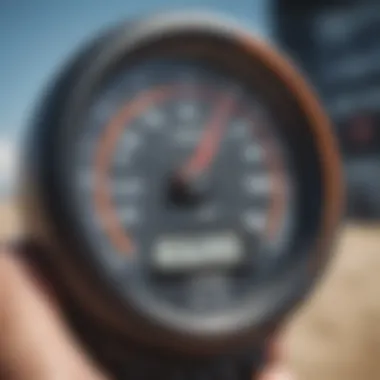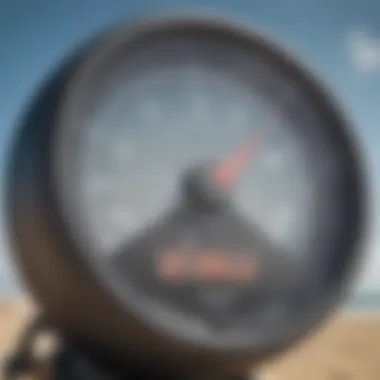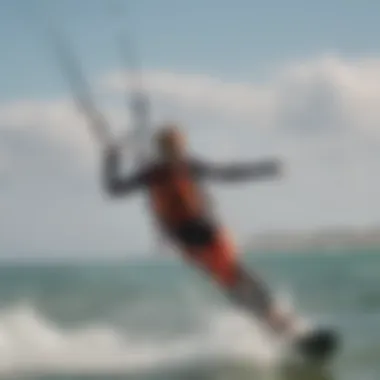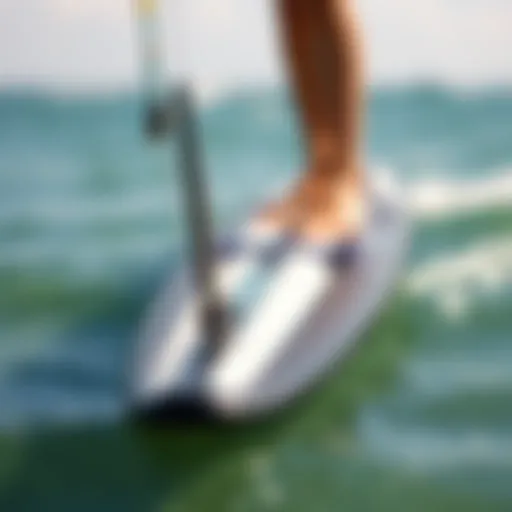Understanding Weather Wind Meters for Kiteboarding


Intro
Kiteboarding is as much an art as it is a science, with the wind being both your best friend and, at times, a formidable adversary. Understanding how to read the wind can be the difference between a spectacular day on the water and a frustrating experience. This is where wind meters come into play, offering insights into wind speed and direction that can significantly enhance your kiteboarding sessions.
For kiteboarders, knowing the wind conditions can lead to better performance. You might think, "What's the big deal? I can feel the wind." But here's the catch: feeling the wind isn’t enough to gauge whether it’s the right time to ride. An accurate wind meter gives you the numbers needed to make informed decisions.
In this guide, we'll cover the ins and outs of weather wind meters, including what types are out there, how they function, and why they are essential for kiteboarding. We aim to arm both seasoned pros and those just dipping their toes into the kiteboarding world with the knowledge they need to hit the water with confidence.
Let’s dive into the vital aspects of gear insights, valuable techniques, and safety practices that every kiteboarder should keep in their toolkit. As we move forward, expect to find not just technical details but also practical advice tailored to your kiteboarding needs.
The Importance of Wind Measurements in Kiteboarding
Kiteboarding, in its essence, dances with the wind. Understanding wind measurements is crucial, not just for a thrilling ride, but for optimal performance and safety. Accurate wind information informs kiteboarders about conditions that could either boost their skills or push them to the edge of their limits. It’s like having a compass in the ocean; without it, navigating becomes a gamble.
Understanding Wind Conditions
To truly grasp the essence of kiteboarding, one has to fathom the complexities of wind conditions. Wind strength and direction can vary significantly even within a few meters. For instance, the subtle shift of breeze from the left can mean all the difference when determining the right kite size. Kiteboarders often refer to the Beaufort scale—a useful guide measuring wind force—ranging from a gentle breeze to a full-blown storm. Being able to assess these conditions ensures that riders aren’t merely relying on gut feelings but are equipped with factual information.
Furthermore, wind patterns can change rapidly. A sunny day might quickly turn into a gusty afternoon or even a still evening. Recognizing the signs of dip and rise in wind tends to create better anticipation for the expected ride. Riders who tune in to these details not only enjoy their sessions but also improve their overall capabilities.
Impact on Performance
Every kiteboarder wants to look good on the water, but achieving peak performance requires understanding the wind’s whims. The force and angle of the wind directly affect speed, height, and agility. Stop and think about it: sailing against a headwind is much tougher than catching a tailwind, right? Using wind measurements can help calculate when to pull off daring tricks versus when to play it safe.
Optimizing one’s kite size based on wind readings—like knowing when to switch from a 7-meter to a 10-meter kite—can enhance not just performance but also enjoyment. A properly scaled kite matches the rider’s skill set, ensuring a connection between rider and wind that feels almost effortless
Moreover, many kiteboarders record data over different sessions, creating a personal wind diary. This sort of diligence allows riders to pinpoint what conditions push them to their extremes or hinder their progress. By analyzing these patterns, kiteboarders can fine-tune their technique and know when to ride and when to hang tight.
Safety Considerations
Safety is indispensable, and wind measurements play a pivotal role in safeguarding kiteboarders from potential hazards. Strong winds or sudden gusts can create dangerous situations, transforming a fun day into a risky encounter with the elements. Knowing when wind speeds cross into the unsafe zone—usually around 25 knots for most setups—can save lives.
In addition to measuring wind strength, awareness of wind direction can reveal shifts that could pose dangers. For example, onshore winds might seem inviting, but they can pull inexperienced riders closer to shore or into restricted areas, creating unforeseen challenges.
"The wind is not a mere factor; it is a partner in your adventure. Knowledge keeps it friendly."
Ultimately, being attuned to wind measurements empowers kiteboarders to protect themselves, ensuring that each session on the water can be enjoyed with confidence. A safe kiteboarder can indulge seriously in the thrill of the sport without the nagging worry of what lurks beneath the surface of unpredictable winds.
Exploring the Types of Weather Wind Meters
When it comes to kiteboarding, understanding wind conditions is half the battle; the other half is knowing how to measure it accurately. Wind meters, also called anemometers, are essential tools for kiteboarders. They help in deciphering air movement, which is crucial for timing your runs and ensuring an enjoyable experience on the water. Different types of wind meters cater to distinct user needs, budgets, and levels of expertise, making it important to explore what’s available.
Not all wind meters are created equal. Each type brings its own set of functionalities, and understanding these differences allows you to make informed decisions to improve your kiteboarding experience.
Mechanical Anemometers
Mechanical anemometers are the old-school gadgets that have been around for ages. They usually come in the form of a rotating vane or cup system. As wind hits these cups or vanes, they spin, and the speed of this rotation gives an indication of the wind speed. The nifty part is their durability—they’re built to withstand rough conditions.
While simple and reliable, mechanical anemometers do require some manual reading. You’ll often need to take a glance at the gauge, which can be a little tricky when you’re focusing on the waves and kite control. Here's why you might consider one:
- Durability: They can take a beating.
- No battery needed: Ideal if you're aiming for simplicity.
- Relatively inexpensive: Great for those just starting out.
However, they may lack precision at lower wind speeds, which is often the case when conditions are less than ideal.
Digital Wind Meters
On the other side of the spectrum, digital wind meters have captured the hearts of technical kiteboarders. These devices display readouts on screens and can measure wind speed, direction, and sometimes even temperature. Many advanced models include data logging features, allowing you to track performance over time.
One of the appealing aspects of digital meters is ease of use. Most of them offer backlit displays and are designed for quick readings, which is handy when you�’re getting ready to hit the water. A few things to consider:
- Accuracy: Generally provide precise readings, even in light winds.
- Features: Additional functionalities like Bluetooth connectivity and smartphone app integration can amplify your experience.
- Price Point: A bit pricier, with higher-end models tailored for serious enthusiasts.


Digital meters tend to make the monitoring process a seamless experience. However, battery life can be an issue, especially if you forget to charge it before your next session.
Smartphone Applications
In today’s tech-savvy world, smartphone applications have made wind measurement more accessible than ever. Various apps utilize GPS and other data to estimate wind speed and direction based on user location. Often, they're backed by real-time updates from weather stations, providing you with instant insight right at your fingertips.
The benefits of using an app include:
- Convenience: Most people always have their phones, so no extra gear to carry.
- Community Insights: Some apps allow users to share real-time wind reports, which can be invaluable.
- Cost-effective: Many quality apps are free or come at a minimal cost compared to physical devices.
However, relying solely on apps might not give you the most accurate readings for on-water conditions, especially if experience varies from what the app reports.
In summary, whether you prefer mechanical anemometers, digital wind meters, or smartphone applications, each has distinct advantages and disadvantages. Ultimately, the choice boils down to your preferences, budget, and how serious you are about your kiteboarding adventures. Look beyond just price; consider what kind of conditions you'll normally experience and how comfortable you are with technology.
How Wind Meters Measure Speed
Understanding how wind meters gauge wind speed is nothing short of essential for kiteboarding enthusiasts. The accuracy of these readings can significantly influence not only performance but also safety on the water. If you’re out there chasing adrenaline, knowing the exact speed of the wind can be the difference between a smooth ride and a less-than-friendly tumble.
More importantly, familiarizing yourself with the principles behind these measurements gives you a deeper appreciation of the technology, ultimately translating into smarter kiteboarding choices. Let's dive deeper into the fundamental aspects of how wind meters function.
Principles of Measurement
Wind meters primarily work on a few core principles that vary depending on the type being used. At their most basic, these devices measure how fast air is moving past them, translating this movement into meaningful data for the user.
- Anemometer Mechanics: Traditional mechanical anemometers use rotating cups or blades that turn in the wind. The speed at which these components spin correlates to the wind speed. The faster they spin, the higher the wind speed registered.
- Digital Sensors: Many digital wind meters employ sensors that measure the airflow electronically. These meters can capture wind direction and speed simultaneously, offering a more comprehensive understanding of conditions.
- Ultrasonic Technology: Some advanced models use ultrasonic pulses to measure how fast air is moving. This method does not rely on moving parts, which can be an advantage in terms of durability and maintenance.
Understanding these principles helps kiteboarders select wind meters that suit their personal style and requirements. For example, if you prefer something rugged for those beach conditions, an ultrasonic meter may be your best bet.
Units of Measurement
When it comes to gauging wind speed, consistency in measurement units is essential for accurate interpretation. While different regions may employ various systems, kiteboarders commonly use the following units:
- Miles Per Hour (MPH): Commonly used in the United States, this measurement is often familiar to casual kiteboarders.
- Kilometers Per Hour (KPH): Predominantly used outside the U.S., this unit offers a broader perspective for international kiteboarding enthusiasts.
- Knots: This unit is especially significant for sailors and is widely used in maritime and aviation contexts. Knowing wind speed in knots gives a precise reading crucial for water sports.
- Meters Per Second (m/s): This is a more scientific unit, often used in meteorology, but less common among casual kiteboarders.
Each has its merits, and the choice often boils down to personal preference and local custom. However, understanding how these units convert from one to another can be very useful. For instance, 1 knot is approximately equal to 1.15 mph. This conversion can save unnecessary head-scratching when planning your next kiteboarding adventure.
"Navigating the waves is just as much about understanding the wind as it is about riding it. Accurate measurements empower better decisions, enhancing performance and enjoyment on the water."
Accuracy and Calibration of Wind Meters
In kiteboarding, where the wind is the true essence of the ride, accuracy in wind measurements can make a world of difference. Kiteboarders depend on precise data to determine wind speed and direction, which directly affects their performance and safety on the water. Thus, embracing the importance of accuracy and calibration within the context of wind meters isn’t just a technicality; it’s a cornerstone for all kiteboarding enthusiasts.
When a wind meter is not calibrated correctly, it can provide misleading data. This misinformation could lead to mishaps, risking not only the entire kiteboarding experience but also the safety of the rider. Therefore, understanding the components that impact accuracy and the methods to calibrate wind meters correctly is vital for all participants in the sport.
Factors Affecting Accuracy
Several elements can influence the accuracy of wind meters, and being aware of these can assist kiteboarders in choosing the right equipment and technique:
- Instrument Quality: Higher-quality wind meters often have more precise sensors, which tend to be less prone to errors.
- Environmental Conditions: External factors such as temperature, humidity, and altitude can skew the readings of a wind meter. Wind meters function best within certain parameters; extreme conditions can lead to inaccurate data.
- Placement: The location of the wind meter matters. For instance, if the device is too close to obstructions like buildings or trees, the wind flow readings can be disrupted, producing incorrect measurements.
- Maintenance: Dust, debris, or water ingress can hinder a meter's functionality. Regular maintenance checks can mitigate these issues and help keep readings reliable.
"In kiteboarding, the wind’s whisper can either guide you to glory or lead you to misfortune. Understanding how to interpret its speech through accurate measurements is crucial."
Calibration Processes
Calibration is the process of adjusting and fine-tuning a wind meter so that it reads wind speed and direction correctly. Here's how one might go about ensuring their wind meter is precisely calibrated:
- Refer to Manufacturer Guidelines: Always start with the instructions from the manufacturer. They usually include specific calibration steps tailored to the unit in question.
- Use Reference Standards: If possible, compare readings of your wind meter with a certified metrological instrument. This step could help identify discrepancies that require adjustment.
- Perform Regular Checks: Regularly verify your wind meter’s accuracy, especially after extended periods of non-use or exposure to harsh weather.
- Adjust for Conditions: When taking readings in unusual conditions, be prepared to adjust the meter accordingly to account for environmental changes.
Regularly calibrating wind meters not only ensures accurate readings but can also lead to better decision-making on the water, influencing not just enjoyment but also overall safety. By tuning in to both the how and why of these processes, kiteboarders can truly harness the wind to their advantage.
Interpreting Wind Data
Interpreting wind data is a crucial element for kiteboarding enthusiasts. The ability to read and understand the information provided by wind meters can be the difference between a thrilling session and an unfortunate mishap. When one takes the time to effectively analyze wind readings, several benefits can be extracted that directly influence performance and safety.


Understanding wind data not only aids in interpreting the immediate conditions but also facilitates a deeper connection with the environment. Kiteboarders need to be aware of the changes in wind speed and direction, as unpredictable gusts or sudden drops can suddenly alter the kite's performance. Having a firm grasp on this aspect can translate to better maneuverability, more controlled jumps, and possibly higher speeds.
Additionally, knowledge of wind data assists in making informed decisions about where to kite and when to pack it up for the day. More often than not, inexperienced kiteboarders assume it’s business as usual; however, knowing how to interpret wind data can prevent unwanted situations on the water, drastically enhancing safety.
"Wind is your friend and your foe; knowing how to read it keeps you safe and soaring!"
Understanding Data Readings
When it comes to understanding data readings from wind meters, one must familiarize oneself with various aspects, including wind speed, gusts, and direction.
- Wind Speed: This is usually measured in knots, miles per hour, or kilometers per hour. Understanding these numbers helps in gauging the potential power the kite can generate.
- Wind Gusts: Sudden increases in wind speed can lead to unexpected changes. Wind gust readings often present themselves as a peak measurement that varies from the overall average wind speed. Recognizing how gusts behave can assist in anticipating adjustments needed when controlling the kite.
- Wind Direction: It’s essential to note where the wind is coming from, as this plays a vital role in setting up for an optimal ride. This is often talked about in terms of degrees, and understanding these directions helps in choosing the right spot to launch your kite.
Understanding these readings allows kiteboarders to make real-time adjustments. Knowledge of how to decipher wind meter readings provides a solid framework upon which kiteboarders can build their experience on the water.
Using Wind Data for Decision Making
The proper interpretation of wind data goes hand-in-hand with informed decision-making on the water. Kiteboarding is as much about skill as it is about making smart choices based on environmental conditions. Here are some ways to utilize wind data effectively:
- Choosing the Right Gear: Knowing the current wind conditions enables kiteboarders to select their gear accordingly. For instance, lighter winds may necessitate a larger kite, whereas stronger winds call for a smaller one.
- Timing Your Sessions: By regularly checking wind data, kiteboarders can better predict favorable conditions throughout the day. This knowledge allows for timing kiteboarding sessions to align with peak wind periods, giving kiteboarders maximum enjoyment.
- Assessing Risks: Understanding the variations in wind data can highlight potential risks in the water. If wind conditions are erratic, or if there are sudden shifts in direction, it’s much safer to save the session for another day.
While it may seem small, the act of interpreting wind data is foundational for making wise decisions. This knowledge allows kiteboarders to leverage their skills while navigating the challenges associated with the constantly shifting winds. The practice of analyzing the data, rather than merely reading it, empowers kiteboarders to elevate their sessions and maximize their safety.
Integrating Wind Meters in Kiteboarding
Understanding how to effectively integrate wind meters into kiteboarding practices is invaluable. Kiteboarding demands not only skill and agility, but also a nuanced grasp of weather conditions, particularly wind. By utilizing wind meters, kiteboarders can refine their approach, ensuring they harness wind power to elevate their performance while safeguarding their safety on the water.
Wind Meter Usage on the Water
Using a wind meter on the water is about practical application paired with real-time decision making. A kiteboarder, upon reaching the launch site, should first check the wind meter to understand the current conditions. This helps in determining the suitability of the day for kiteboarding. If the wind is too light, it can be hard to get enough lift; on the contrary, if it's too strong, it may prove risky.
- Initial Setup: Before jumping into the water, being familiar with the readings on your wind meter is key. Wind speeds typically range from 5 to 30 knots or more. Knowing the thresholds for different kite sizes is essential. For example, a 12-meter kite may work best in 12-20 knots of wind.
- Ongoing Monitoring: While riding, it's helpful to gauge the wind conditions continuously. This can dictate your riding style. For instance, if the wind picks up unexpectedly, you might need to adapt your technique or pack up to avoid accidents.
- Communication: Whether alone or with friends, sharing wind meter data can enhance group safety. For instance, if a buddy notices the wind shifting to an unsafe level, they can alert others to reevaluate their adventure before it becomes a problem.
By integrating these practices, kiteboarders can ride with greater confidence, focusing on the thrill of the sport rather than the unpredictability of the weather.
Environmental Considerations
Kiteboarding is often practiced in natural settings, which places importance on being mindful of environmental factors when utilizing wind meters. A wind meter doesn't just provide raw data—it also engages riders with their surroundings.
- Weather Patterns: Understanding patterns that affect wind can be crucial. For example, coastal areas often experience shifts in wind due to geographical features. Hills, buildings, or vegetation can create turbulence, impacting your readings. Mapping local weather patterns could provide insight into this.
- Respect Local Wildlife: Certain areas may be habitats for wildlife, particularly birds. By using wind meters to choose the right kiteboarding locations and conditions, enthusiasts can minimize their impact on local ecosystems.
- User Responsibility: Lastly, kiteboarders must take responsibility by ensuring that their activities do not contribute to pollution or littering. Using a wind meter can help select times that are more favorable when crowds are smaller, thus reducing stress on any areas that are prone to ecological threats.
Together, these elements form a framework of best practices for incorporating wind meters into kiteboarding—enhancing safety, performance, and respecting the natural world.
Alternatives to Traditional Wind Meters
When it comes to kiteboarding, having a reliable way to gauge wind conditions is key. Traditional wind meters, while effective, aren't the only tools out there. Exploring alternative options can provide a kiteboarder with a clearer picture of what's happening in their chosen spot, broadening their understanding of wind dynamics. These alternatives often have unique benefits and can fit various budgets and preferences.
Weather Stations and Forecasting
Weather stations are like mini meteorological hubs packed with an assortment of sensors. They compile data from various sources, offering real-time updates about wind speed, direction, and temperature. There's something to be said for having this level of detail at your fingertips when preparing for a kiteboarding session.
- Benefits: They generally provide more comprehensive data than a handheld wind meter. For example, a weather station might give you up-to-the-minute changes in wind patterns over your local area, allowing you to act more decisively. Plus, many stations are accessible online or via smartphone apps.
- Considerations: Accessibility can be a double-edged sword. Depending on your location, not all weather stations may be readily available. Moreover, while they are reliable, they can sometimes lag behind real-time changes in local wind conditions.
Community Reports and Resources
The kiteboarding community is frequently buzzing with information from enthusiasts just like yourself. Local kiteboarding clubs or groups often share wind reports based on their own experiences on the water. This peer-generated data adds a personal touch that forecasts from distant weather stations lack.
- Benefits: Community reports can include local nuances that a general forecast may miss, such as the effect of geographical features or recent weather changes. If a friend mentions that the winds picked up at a certain spot after a rain shower, you might decide that’s the perfect time to catch some waves.
- Considerations: While it's wonderful to have this insider information, keep in mind that community reports can also lack consistency. A few kiteboarders' takes about the wind might differ, so weighing multiple opinions is essential to avoid surprise conditions.
"Kiteboarding isn’t just about the sport; it’s about sharing experiences with your peers, making community insights invaluable to a session!"
In summary, considering alternatives to traditional wind meters can vastly improve your kiteboarding strategy. By making use of weather stations and tapping into community wisdom, you equip yourself with a rich tapestry of data that can enhance your decision-making on the water.
Future Trends in Wind Measurement Technology


As kiteboarding evolves, so do the tools that enthusiasts use to gauge the wind. The future of wind measurement technology is pivotal for improving both performance and safety on the water. With kiteboarding relying heavily on accurate wind conditions, embracing innovative technologies can provide kiteboarders with an edge, ensuring they make the most of their time in the great outdoors. This section will dive into upcoming trends that could reshape how we perceive and measure wind, offering insights into possibilities that extend beyond mere gadgets.
Emerging Technologies
The landscape of wind measurement is undergoing a transformative shift. Traditional methods, while effective, are being complemented and sometimes replaced by groundbreaking technologies that promise enhanced capabilities. Some noteworthy innovations include:
- IoT Devices: Internet of Things (IoT)-enabled anemometers allow real-time data sharing. Imagine a small sensor attached to your kite that sends live wind data to your smartphone while you’re gliding over the waves.
- Drone Technology: Drones equipped with wind meters can capture data from various altitudes, offering a perspective on wind conditions that ground-based devices may miss. They can survey the area before you hit the water, providing invaluable insights into safe kiteboarding spots.
- Integrative Wearables: New wearable technology, such as smartwatches or fitness trackers, is being integrated with wind measurement capabilities, potentially allowing for on-the-fly adjustments to your kiteboarding strategy based on current conditions.
These advances will not only make measurements more accurate but could also provide kiteboarders with a real-time grasp of changing wind patterns. Keeping a finger on the pulse of technological innovations can mean better decisions and, ultimately, a more enjoyable experience on the water.
Potential for Increased Accuracy
With the emergence of sophisticated technologies, accuracy in wind measurement is set to improve significantly. Historically, various factors like location and environmental conditions influenced the precision of wind readings. However, the following advancements hold great promise for better accuracy:
- Advanced Algorithms: New algorithms designed for analyzing wind patterns and behaviors in real-time could provide kiteboarders with precise and usable data, transforming how they interpret wind conditions.
- Multi-Sensor Systems: Combining readings from several sensors allows for a more comprehensive view of wind patterns. This integration can compensate for anomalies and create an overall more accurate reading, ensuring that users have confidence in the data.
- AI and Machine Learning: Deploying artificial intelligence in wind data analysis can lead to predictive models that estimate future wind conditions based on historical data. This foresight could be invaluable for kiteboarders who want to know how the day’s sessions are likely to unfold.
"With the right tools, kiteboarders can navigate the complexities of wind, turning challenging conditions into exhilarating experiences."
By staying abreast of emerging technologies and their potential for enhancing accuracy, kiteboarders can significantly improve their performance and safety while out on the water, making for memorable adventures.
Tips for Choosing the Right Wind Meter
Selecting the appropriate wind meter is crucial for enhancing your kiteboarding experience. The right device can not only improve your performance but can also ensure safety on the water. With a myriad of options available, understanding what factors to consider will steer you clear of costly mistakes and help you make an informed choice.
Assessing Your Needs
Before you even think about making a purchase, it's essential to assess your specific needs for kiteboarding. The environment you typically ride in, along with your skill level, can greatly influence what kind of wind meter is most suitable for you.
For instance, if you're predominantly riding in locations with consistent wind conditions, a basic mechanical anemometer may do the trick. However, if you're frequently facing erratic wind patterns or if you're at an advanced level, you might lean towards a digital meter that offers more data insights, like average wind speed and gusts.
Consider these aspects:
- Location: Where do you kiteboard? Coastal areas often have different wind patterns compared to lakes.
- Skill Level: Are you just starting out or are you a seasoned pro?
- Wind Usage: Will you mostly use it for recreational purposes, or is race performance a key focus?
- Portability: Do you travel frequently? Compact units might suit you better.
By keeping these points in mind, you can choose a meter that aligns perfectly with your kiteboarding demands.
Budget Considerations
Cost is always a factor when making any significant purchase, and wind meters are no exception. The price range can vary widely from under fifty dollars for basic models to several hundreds for advanced devices with all the bells and whistles.
When considering your budget, think about the following:
- Initial Investment vs. Long-Term Value: A more expensive device might offer durability and advanced features, which could be a better long-term investment.
- Features Needed: Do you really need GPS tracking, or will a simple cup-style anemometer suffice?
- Reviews and Recommendations: Do some homework by checking ratings and feedback from fellow kiteboarders. Websites like reddit.com or facebook.com can be good sources of community advice.
- Sales and Discounts: Keep an eye out for sales or second-hand options; often, last year's models can be found at greatly reduced prices.
Ultimately, finding a wind meter that fits your budget while meeting your needs can significantly enhance your sessions, ensuring you're both safe and thriving on the water.
Maintaining Your Wind Meter
When it comes to kiteboarding, having a reliable wind meter isn’t just a nicety—it's an absolute necessity. Regular maintenance of your wind meter can not only extend its life but also ensure accurate readings, which is crucial for both performance and safety on the water. Just like you wouldn't drive a car without regular oil changes, you shouldn't overlook the maintenance of your wind meter. The right upkeep can prevent misreadings that might lead to unfortunate situations, especially during high-stakes kiteboarding sessions.
Routine Maintenance Practices
Maintaining your wind meter isn't laborious, but a slight oversight can lead to inaccuracies. Here are some practical steps to keep your device in tip-top shape:
- Keep it Clean: Just as sand can ruin a perfectly good beach day, dirt and debris can wreck the performance of your wind meter. Gently wipe down the exterior and remove any particles from the sensors using a soft, lint-free cloth. Avoid harsh chemicals—sometimes, a little warm water is all you need.
- Check the Battery: Nothing puts a damper on a kiteboarding session like discovering your wind meter has a dead battery right when you need it the most. Regularly check and replace batteries as needed, particularly before a trip. This simple practice can save you a world of trouble.
- Test After Exposure to the Elements: Weather is fickle, and so can your devices be. Inspect your wind meter after heavy rain or from being out in the saltwater. Whether it's a water-resistant model or not, moisture can cause issues. Make sure there are no signs of internal damage or corrosion.
- Store Properly: When you've finished your session and are heading back home, how you store your wind meter matters too. A padded case can protect it from bumps and knocks, ensuring its longevity. Avoid leaving it in extreme temperatures — whether too hot or too cold can affect its functionality.
Doing these small checks regularly can keep your wind meter as reliable as your best kite.
Troubleshooting Common Issues
Even with the best care, wind meters can sometimes misbehave. Recognizing these common issues can help you quickly get back on track to measuring wind speeds accurately:
- Inaccurate Readings: If your readings seem off, first ensure that the device is clean, specifically around the anemometer blades. Sometimes, just a speck of sand can disrupt the calibration. If cleaning doesn’t help, you might need to recalibrate, which many digital models allow.
- Intermittent Functionality: If your wind meter turns off and on without warning, it might be a battery issue. Replace the batteries, but if problems persist, checking for corrosion or dirt in the battery compartment could reveal the culprit.
- No Display: If the display fails to show any reading at all, ensure that the meter is powered on. If you’ve just switched the unit on and it shows nothing, a hard reset may be in order.
Pro Tip: Many wind meters have a reset button, so make use of it according to the manufacturer's instructions.
- Freezing or Sticking Anemometer: If blades on the wind meter aren't moving, it could be stuck due to dirt or being jammed. In such cases, a gentle clean with a soft brush can free them up. If the design allows, a drop of light lubricant can work wonders too.
In summary, maintaining your wind meter doesn't take a lot of time but can make a world of difference in your kiteboarding experience. Keeping it clean and functional minimizes mistakes and enhances the joy of riding.















